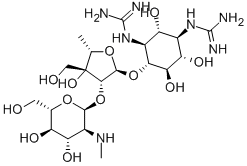- Dihydrostreptomycin
-

- $1.00 / 1g
-
2019-12-26
- CAS:128-46-1
- Min. Order: 1g
- Purity: ≥98%
- Supply Ability: g/kg/Ton
|
| | Dihydrostreptomycin Basic information |
| Product Name: | Dihydrostreptomycin | | Synonyms: | DIHYDROSTREPTOMYCIN;Dihydrostreptomycin (base and/or unspecified salts);2-[(1S,3R,4S,5R,6R)-5-(Diaminomethylideneamino)-2-[(2R,3R,4R,5S)-3-[(2S,3S,4S,5R,6S)-4,5-dihydroxy-6-(hydroxymethyl)-3-methylaminooxan-2-yl]oxy-4-hydroxy-4-(hydroxymethyl)-5-methyloxolan-2-yl]oxy-3,4,6-trihydroxycyclohexyl]guanidine;Acetonitrile, 2-benzimidazolyl-;Benzimidazole, 2-cyanomethyl;4-O-[2-O-[2-(Methylamino)-2-deoxy-α-L-glucopyranosyl]-5-deoxy-3-hydroxymethyl-α-L-lyxofuranosyl]-N,N'-bis(aminoiminomethyl)-D-streptamine;DHSM;DihydroestreptoMycin Sulfate | | CAS: | 128-46-1 | | MF: | C21H41N7O12 | | MW: | 583.59 | | EINECS: | 204-888-2 | | Product Categories: | | | Mol File: | 128-46-1.mol |  |
| | Dihydrostreptomycin Chemical Properties |
| Melting point | >300 °C | | Boiling point | 641.09°C (rough estimate) | | density | 1.3963 (rough estimate) | | refractive index | 1.6800 (estimate) | | pka | pKa 7.8 (Uncertain) |
| Provider | Language |
|
2-[(1S,3R,4S,5R,6R)-5-(Diaminomethylideneamino)-2-[(2R,3R,4R,5S)-3-[(2S,3S,4S,5R,6S)-4,5-dihydroxy-6-(hydroxymethyl)-3-methylaminooxan-2-yl]oxy-4-hydroxy-4-(hydroxymethyl)-5-methyloxolan-2-yl]oxy-3,4,6-trihydroxycyclohexyl]guanidine
| English |
| | Dihydrostreptomycin Usage And Synthesis |
| Description | Dihydrostreptomycin was first synthesized by Parke Davis Co. in 1946by the reduction of streptomycin. Naturally occurring dihydrostreptomycin was found in the culture broth of Streptomyces humidus by Takeda Chemicals Industries in 1957. Its hydrochloride or sulfate is more easily crystallized and more stable under alkaline conditions than streptomycin. Dihydrostreptomycin has been used for therapy of tuberculosis, but because it has a higher ototoxicity than streptomycin its use is now restricted to animal therapy. | | Originator | Dihydrostrepto,MSD ,US,1948 | | Uses | Antibacterial. | | Definition | ChEBI: Dihydrostreptomycin is a member of streptomycins. | | Manufacturing Process | Dihydrostreptomycin sulfate may be prepared from streptomycin sulfate by
catalytic hydrogenation (Merck, Pfizer, Cyanamid), electrolytic reduction
(Schenley, Olin Mathieson), or by sodium borohydride reduction (Bristol), or
by isolation from a fermentation process (Takeda). | | Brand name | Abocillin;Biostrep;Complexobiotico;Diapenin 3;Diapenin balsamico;Diarrestival;Didromycin;Didrothenate;Dihydrocidan sulfato;Dihydrostreptofar;Diidro-pantostrept;Distreptopab;Dreiciclina balsamica;Dst;Entera-strept;Estreptoluy;Estreptosirup;Helle-strep-forte;Hp 48;Mastigun;Mixtencillin;Retromyopen;Rocopenstrep;Sanstrepto;Solmycin;Solvo-strept;Streptoduocin;Veticar;Veycil-as. | | Therapeutic Function | Antibiotic | | World Health Organization (WHO) | Dihydrostreptomycin, a derivative of the aminoglycoside
antibiotic streptomycin with similar antibacterial activity, was first synthesized in
1947 and subsequently used in the treatment of tuberculosis and gram-negative
infections. Preparations for systemic use have been widely withdrawn as a result
of concern regarding their severe ototoxicity. Dihydrostreptomycin is poorly
absorbed from the gastrointestinal tract. It remains available in oral preparations in
some countries. | | Safety Profile | Poison by intravenous
and intramuscular routes. Moderately toxic
by subcutaneous and intraperitoneal routes.
Human teratogenic effects by unspecified
route: developmental abnormahties of the
eye and ear. An experimental teratogen.
Other experimental reproductive effects.
Mutation data reported. A derivative of
streptomycin; has anesthetic properties.
When heated to decomposition it emits
toxic fumes of NOx |
| | Dihydrostreptomycin Preparation Products And Raw materials |
|